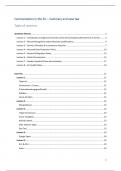Samenvatting
Harmonisation in the EU - Summary and case law
Grade: 8. This document contains a comprehensive summary for the course Harmonisation in the EU. This summary is based on extensive notes from the lectures and reading the prescribed case law. The document includes relevant articles and references to the mandatory case law. The case law is elabora...
[Meer zien]




